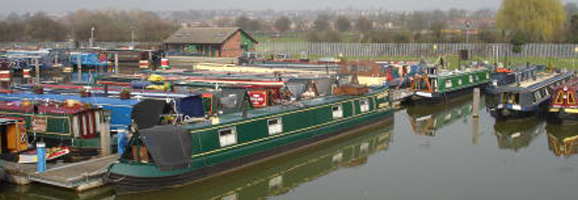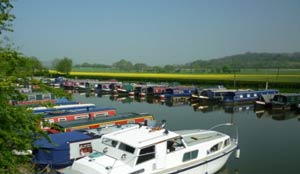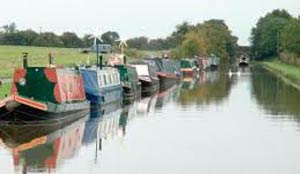
In this article I’ll try to show what options are available with regards to narrowboat mooring particularly residential moorings on the canals and rivers of the UK. I am not going to discuss the rights and wrongs of the interpretation of the rules – these have been written about at great length and wildly differing opinions can be found on any canal user forum and canal magazine Readers Letters pages every month. On a personal note, your author has continually cruised, moored in a marina, had a long term online mooring from BW and moored on private land alongside the canal, so I feel reasonably well placed to offer an opinion of the advantages and disadvantages of all types of narrowboat moorings.
It’s a sad fact, but one of the things many new narrowboaters (or indeed any boat using the canals and rivers of the UK) tend to overlook is the fees associated with mooring your vessel. There is an awful lot written about the merits and otherwise of continuous cruising i.e. without any form of permanent mooring for your boat (but I’ll come back to this later in this article.)
Put bluntly, if you own a boat and do not ‘continually cruise’ you will need somewhere to moor that boat when you are not using it. There are a number of different ways and types of mooring and each has its own merits (and drawbacks). I don’t want to politicise this article so I will try and show the various alternatives available and leave it to you to decide which is best for your needs.
On the face of it, there are two places you can moor your narrowboat – either alongside the canal (sometimes called tow-path moorings) or within the confines of a marina.
Marina moorings
These can offer the boater added security with additional services, such as an electric hook-up, fresh water and refuse disposal, and many are able to provide engineering services from a resident marine engineer – useful if you want to keep your boat in tip top condition, but are unsure (or unwilling!) to carry out the work yourself. Some marinas offer parking places for your car while you are out cruising on your boat, but may have rules in place as to how long you can stay on your vessel whilst it is inside the marina.
 As more and more people look to the canals as a way of living on a narrowboat, some marinas are turning a blind eye to what are often described as ‘long term moorers’. These are individuals who effectively use their boat as either a second home for part of the year or (as is becoming more common) live on that boat all year round with a friend or relative providing a ‘home address’ for paperwork purposes.
As more and more people look to the canals as a way of living on a narrowboat, some marinas are turning a blind eye to what are often described as ‘long term moorers’. These are individuals who effectively use their boat as either a second home for part of the year or (as is becoming more common) live on that boat all year round with a friend or relative providing a ‘home address’ for paperwork purposes.
Marina rates vary dramatically, particularly around the country, and in popular areas in the south for example, can exceed £5000 a year for a 50ft boat. Remember – this is on top of your ‘normal’ cruising licence that is paid to the licencing authority.
Rates for narrowboat moorings in London and in particular, narrowboat moorings in Central London, can be higher still, but you must also remember that it is not just the cost that is a problem – the scarcity of these moorings mean that they command a premium and just finding a permanent mooring is an issue. Sometimes, potential boaters can circumvent the usual waiting list for a mooring by buying a boat that is already moored on a permanent site – but a word of caution here – you must ensure that the seller has the right to transfer his / her mooring. Get in touch with the owner of the moorings themselves to confirm this, before parting with your money….
Contract lengths for mooring can vary from a full 12 month moorings to those where just a week or two is required. Even boaters who continually cruise will often moor in a marina for a month or two over the winter to avoid the worst that the British weather can throw at them.
Online Moorings
As mentioned earlier, online moorings usually mean those alongside the towpath (or opposite side of the canal). Some of these are owned by BW – or The Canal and River Trust, some are owned by Local Authorities or Park Agencies in such places as Milton Keynes and Loughborough and some are owned by private landowners.

Facilities vary dramatically from none whatsoever, to water / refuse and electric points. Unlike marina moorings, security can be an issue, and the only time I have ever had anything stolen from a narrowboat has been when it has been moored alongside the canal. It is also important to remember that even on privately owned moorings; you will normally have to pay the Canal and River Trust for a Mooring Licence as well as the owner of the land – and all of this is on top of your ‘normal’ boat licence costs.
Many areas of the canal are designated as ‘visitor moorings’. In essence, the narrowboat owner can moor alongside a length of bank for a period (usually not exceeding 14 days). Read the mooring notices carefully though. Several places where mooring is popular have much shorter visitor waiting periods, and additional charges are made for narrowboats who overstay. As these can be quite hefty, the narrowboater who ignores the mooring notice can find themselves with an unwelcome bill at the end of their mooring period.
Continuous Cruising
OK – I’ve left the contentious one till last. The Canal and River Trust accept that the law is quite ambiguous and as a result, have published their ‘Guidance for boaters without a home mooring’. In it, they state that:
You must use your boat to genuinely cruise in a mainly progressive fashion (A to B to C to D rather than A to B to A to B) from place to place and must not stop for more than 14 days in any one place, except in exceptional circumstances beyond your control.
They also say that if you don’t move your boat across a wide enough area or stay in one place too long, they might actually apply to have your boat removed from the water.
As a result, and by way of guidance, the Canal and River Trust suggest you ask yourself two questions to see if you fit the continuous cruiser ‘profile’.
- Are you free of obligations that would see you having to remain in one area, such as childcare or education, employment or health care?
- Can you commit to moving your boat to a truly new area every 14 days
They suggest that if you answer no to either of those questions, then you could not really consider yourself a continuous cruiser.
Available moorings are often advertised in boating magazines so a regular trawl through these can be useful, as can a visit to marinas in the area that you would like to moor your boat.
